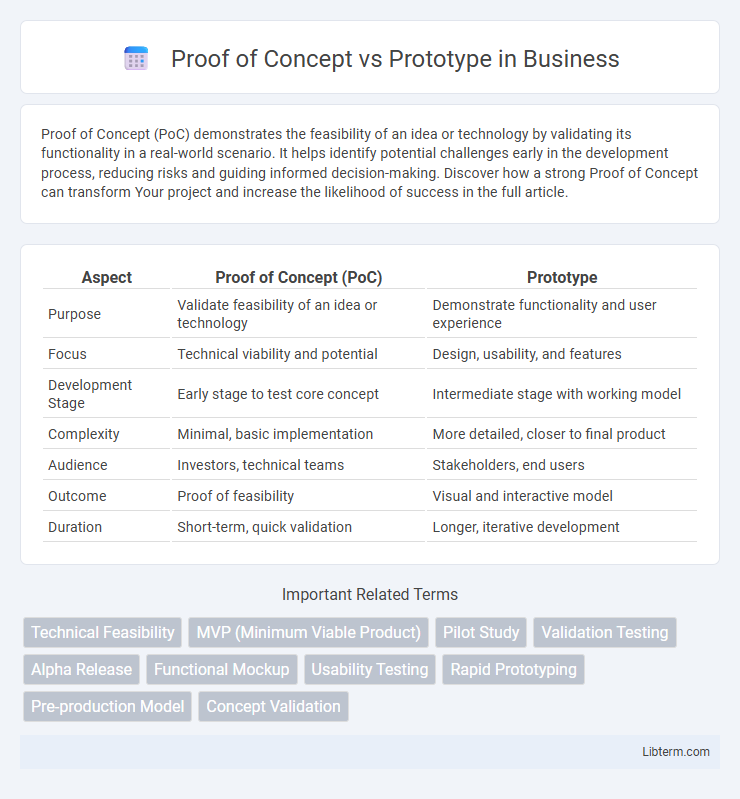Proof of Concept (PoC) demonstrates the feasibility of an idea or technology by validating its functionality in a real-world scenario. It helps identify potential challenges early in the development process, reducing risks and guiding informed decision-making. Discover how a strong Proof of Concept can transform Your project and increase the likelihood of success in the full article.
Table of Comparison
| Aspect | Proof of Concept (PoC) | Prototype |
|---|---|---|
| Purpose | Validate feasibility of an idea or technology | Demonstrate functionality and user experience |
| Focus | Technical viability and potential | Design, usability, and features |
| Development Stage | Early stage to test core concept | Intermediate stage with working model |
| Complexity | Minimal, basic implementation | More detailed, closer to final product |
| Audience | Investors, technical teams | Stakeholders, end users |
| Outcome | Proof of feasibility | Visual and interactive model |
| Duration | Short-term, quick validation | Longer, iterative development |
Introduction to Proof of Concept and Prototype
Proof of Concept (PoC) is a small-scale demonstration designed to validate the feasibility and potential of a new idea, technology, or approach before full-scale development. A Prototype is a functional model built to test, refine, and demonstrate the design, usability, and functionality of the product concept in a tangible form. Both PoC and prototypes serve critical roles in the innovation process, helping stakeholders evaluate technical viability and user experience early on.
Defining Proof of Concept
Proof of Concept (PoC) demonstrates the feasibility and potential of an idea or technology to solve a specific problem, often focusing on validating key assumptions before full-scale development. It involves testing critical functionalities in a controlled environment to assess viability without creating a complete product. In contrast, a prototype is a preliminary model built to showcase design, functionality, and user experience, often used to gather feedback and refine the final solution.
Understanding Prototype
A prototype is a tangible, functional model that demonstrates a product's design, features, and user experience, allowing stakeholders to test and refine concepts before full-scale development. Unlike a proof of concept, which validates feasibility or technical aspects, a prototype provides a more complete representation of the final product's look and feel. Creating prototypes accelerates user feedback collection, lowers risk of costly redesigns, and enhances collaboration across design and engineering teams.
Key Differences Between Proof of Concept and Prototype
Proof of Concept (PoC) validates the feasibility of an idea or technology, focusing on whether a concept can be achieved technically and practically. A Prototype is a working model developed to demonstrate and refine the design, functionality, and user experience of a product before full-scale production. PoCs address viability and risk reduction, while prototypes emphasize user interaction and iterative development.
When to Use Proof of Concept
Proof of Concept (PoC) is used early in the development process to validate the feasibility of an idea or technology before committing significant resources. It helps identify technical challenges and assess whether a concept can be successfully implemented, reducing project risks. PoCs are ideal for exploring innovative solutions, testing core functionalities, and securing stakeholder buy-in prior to creating a functional Prototype.
When to Use a Prototype
Use a prototype when visualizing user interface design, testing functionality, or gathering user feedback is essential before full-scale development. Prototypes help validate design concepts and identify usability issues by providing an interactive model close to the final product. This approach reduces risks by enabling iterative improvements through hands-on experimentation and stakeholder engagement.
Benefits of Creating a Proof of Concept
Creating a Proof of Concept (PoC) validates the feasibility of an idea before substantial resources are invested, minimizing financial risk. A PoC enables teams to identify technical challenges and address potential issues early in the development process. This approach accelerates stakeholder buy-in by demonstrating practical viability through tangible evidence, leading to more informed decision-making.
Advantages of Prototyping
Prototyping enables early visualization and testing of design concepts, allowing teams to identify and resolve usability issues before full-scale development. It facilitates effective stakeholder communication by providing tangible models that demonstrate functionality and design intent. Rapid iteration and feedback during prototyping significantly reduce development risks and costs by minimizing late-stage changes.
Common Mistakes in Proof of Concept and Prototype Development
Common mistakes in Proof of Concept (PoC) development include over-engineering the solution, aiming to build a fully functional product rather than validating core assumptions, which leads to wasted time and resources. Prototype development often faces errors like neglecting user feedback and failing to iterate quickly, resulting in designs that do not meet actual user needs or technical requirements. Confusing PoCs with prototypes can cause teams to lose focus on the primary goal of validation versus user experience exploration, hindering project progress and clarity.
Choosing the Right Approach: Proof of Concept vs Prototype
Choosing the right approach between a proof of concept (PoC) and a prototype depends on project goals and risk assessment. A PoC validates feasibility and technical functionality before full development, minimizing uncertainty in innovation-driven projects. Prototypes focus on user experience and design iteration, essential for refining product features and market fit through early feedback.
Proof of Concept Infographic

 libterm.com
libterm.com